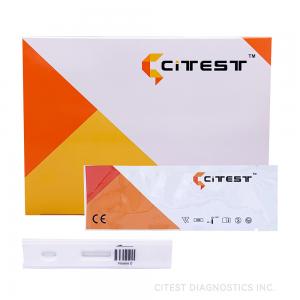

Add to Cart
| Principle | Fluorescence Immunoassay |
| Format | Cassette |
| Specimen | Serum/Plasma |
| Certificate | CE |
| Reading Time | 15 minutes |
| Pack | 10T/25T |
| Storage Temperature | 4-30℃ |
| Shelf Life | 2 Years |
Vitamin D Test Cassette (Serum/Plasma), Fluorescence Immunoassay Test,Vitamin D (D2+D3)
A Fluorescence Immunoassay quantitative detection of total Vitamin D (D2+D3) in human serum or plasma with the use of Fluorescence Immunoassay Analyzer.
For professional in vitro diagnostic use only.
INTENDED USE
Vitamin D Test Cassette (Serum/Plasma) is intended for in vitro quantitative determination of total Vitamin D in serum or plasma. Measurement of total Vitamin D (D2+D3) is used as an aid to assessment of Vitamin D levels.
SUMMARY
Vitamin D refers to a group of fat-soluble secosteroids responsible for increasing intestinal absorption of calcium, iron, magnesium, phosphate, and zinc. In humans, the most important compounds in this group are vitamin D3 and vitamin D2. Vitamin D3 is naturally produced in the human skin through the exposure to ultraviolet light and Vitamin D2 is mainly obtained from foods. Vitamin D is transported to the liver where it is metabolized to 25-hydroxy Vitamin D. In medicine, a 25-hydroxy Vitamin D blood test is used to determine Vitamin D concentration in the body. The blood concentration of 25-hydroxy Vitamin D (including D2 and D3) is considered the best indicator of Vitamin D status.
Vitamin D deficiency is now recognized as a global epidemic. Virtually every cell in our body has Receptors for Vitamin D, meaning that they all require “Sufficient” Level of Vitamin D for adequate functioning. The health risks associated with Vitamin D deficiency are far more severe than previously thought. Vitamin deficiency has been linked to various serious diseases: Osteoporosis, Osteomalacia, Multiple Sclerosis, Cardiovascular Diseases, Pregnancy Complications, Diabetes, Depression, Strokes, Autoimmune Diseases, Flu, Different Cancers, Infectious Diseases, Alzheimer, Obesity and Higher Mortality etc. Therefore, now detecting (25-OH) Vitamin D level is considered as “Medically Necessary Screening Test”, and maintaining sufficient levels not just to improve bone health, but to improve overall health and well-being.
PRINCIPLE
The Vitamin D Test Cassette (Serum/Plasma) detects Vitamin D based on Fluorescence Immunoassay. The sample moves through the strip from sample pad to absorbent pad. Vitamin D in the sample will compete with the VD-BSA antigen coated on the membrane. The less Vitamin D in the sample, the more fluorescent microspheres conjugated with anti-VD antibodies can be captured by the VD-BSA antigen coated on the membrane (Test line). The concentration of Vitamin D in the sample is inversely related to the intensity of the fluorescent signal captured on the T line. According to the fluorescence intensity of the test and the standard curve, the concentration of Vitamin D in the sample can be calculated by the Fluorescence Immunoassay Analyzer to show Vitamin D concentration in the sample.
REAGENTS
The test include VD antibody coated particles and VD-BSA antigen coated on the membrane.
PRECAUTIONS
DIRECTIONS FOR USE
Refer to Fluorescence Immunoassay Analyzer Operation Manual for the complete instructions on use of the analyzer. The test should be conducted at room temperature.
Allow the test, specimen, buffer and/or controls to reach room temperature (15-30°C) prior to testing.
Caution: There are different test modes of the Fluorescence Immunoassay Analyzer. The difference between them is incubation of the test cassette is outside or inside the analyzer. Choose test mode accordingly and confirm sample type. Consult the user manual of the analyzer for detailed operation information.
Operator must consult the Fluorescence Immunoassay Analyzer User Manual prior to use and become familiar with the processes and quality control procedures.
INTERPRETATION OF RESULTS
Results read by Fluorescence Immunoassay Analyzer.
The test result of Vitamin D is calculated by Analyzer and reported as the numerical value with unit ng/mL and results with Def/Insuf/Suf (shorted from Deficient/Insufficient/Sufficient). The detection range of Vitamin D Test Cassette is 5-100ng/mL.
QUALITY CONTROL
Each Vitamin D Test Cassette contains internal control that satisfies routing quality control requirements. This internal control is performed each time a sample is tested. This control indicates that the test device was inserted and read properly by Fluorescence Immunoassay Analyzer. An invalid result from the internal control causes an error message on Fluorescence Immunoassay Analyzer indicating that the test should be repeated.
Order Information
| Cat. No. | Product | Specimen | Pack |
| FI-VD-CT302 | Vitamin D Test Cassette | Serum/Plasma | 10T/25T |
